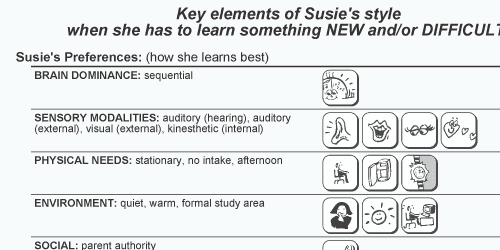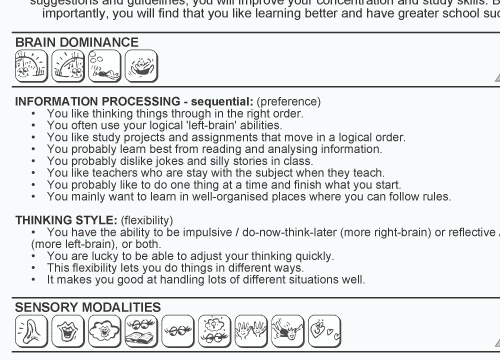We use Learning Styles every day of our lives, whether we're aware of it or not. The way we think, the way we read, the way we treat our partners... it's all encoded in our Learning Styles. Do you want to see yours?
WWW.CREATIVELEARNINGCENTRE.COM
Thursday, November 20, 2014
Learning Resources: Do you prefer technology or tradition?
Whether you embrace technology or prefer the tried-and-tested resources will depend, in part, on your Learning Style. But here's an interesting argument from IKEA (with our apologies to Apple). Have a look.
Thursday, August 21, 2014
Fun Education Apps
- StoryKit - an awesome app that allows users to create an electronic storybook via illustrations by drawing on the screen, using pictures and text, and recording audio to attach to stories.
- Video Science - A growing library of hands-on science lessons. These short videos demonstrate inexpensive and easy to recreate experiments that are designed to inspire and excite kids of all ages.
- Google Earth - Explore the planet: search for cities, places, and businesses. Browse layers including roads, borders, places, photos and more. Visit the Earth Gallery to find exciting maps such as real-time earthquakes, planes in flight, hiking trails, city tours, and more.
- Hubble Space Telescope Discoveries - Soar through the universe with the Hubble Space Telescope, exploring dark energy and colliding galaxies.
- Solve the Outbreak - Get clues, analyze data, solve the case, and save lives! In this fun app, you get to be the Disease Detective. Do you quarantine the village? Talk to people who are sick? Ask for more lab results? The better your answers, the higher your score – and the more quickly you’ll save lives. You’ll start out as a Trainee and can earn badges by solving cases, with the goal of earning the top rank: Disease Detective.
Thursday, May 08, 2014
How sequential and simultaneous thinkers use computers to learn
Schools all over the world are doing it: making tablet computers compulsory for students, ordering smart boards, redesigning classrooms into e-learning centres. It’s cool. It’s trendy. It simulates the future workplace. But is it for everybody?
When it comes to internal information processing, learners will always use either sequential/analytic or impulsive/holistic brain processing and will either need to reflect or think simultaneously about the learning content. Therefore, online-learning situations and course organisation need to take these style differences into account.
Generally speaking, people with a sequential/analytic dominance are linear thinkers who like facts, details and logic. They want their learning materials neat and organised, and they will read them from the beginning to the end, without skipping around. They learn step-by-step, prefer logical and analytic arguments and focus on details and facts. To cater to their needs, the online-learning package should:
- Make frequent use of keywords.
- Make use of lists and bullet points.
- Explain all procedures to be used.
- Detail all the assignments and objectives.
- Underline important facts and arrange them in sequence.
- Proceed step-by-step through detailed information.
- Have a facility to assess the student’s progress frequently.
- Provide instant and regular feedback on the student’s progress.
- Relate the lesson to the students’ experience.
- Use practical examples.
- Provide an overview of the concepts.
- Make use of mind-maps.
- Make use of summaries.
- Allow the students to discover the facts by themselves.
- Allow the students to map, graph or illustrate the material.
- Give positive feedback, even for small achievements.
Friday, October 04, 2013
Technology At School - Good or Should We Think Again?
But is it for everybody?
By its very nature, e-learning is best suited to highly visual people, because of the wealth of imagery offered by the computer: text, pictures and diagrams, graphs, photos, videos. Please note that we distinguish the following types of visual learners: visual (pictures), visual (reading), visual (internal). While the former two styles are well suited to online learning, the latter one, which relies on forming images in one’s mind, is neutrally suited to online learning (i.e., it is neither enhanced nor limited by the use of computers).
Auditory (listening) learners can be accommodated if the online-learning course uses recorded speech and sound-effects (such as pings). Externally auditory learners who need to discuss the learnt material can be accommodated by using voice chat facilities.
Tactile learners are disadvantaged, although their need can be partially satisfied by touch-pads, mice and/or touch-screens. For the tactile learners, online-learning can be further enhanced by having to match pieces of a puzzle on the screen or match questions and answers using the drag-and-drop technique. Such students can also be encouraged to make their own memory aids offline, such as sculptures of molecules or board games depicting new topics.
The real challenge, however, comes with externally kinesthetic learners who need to move around and learn with their whole bodies. Because they rely on real experiences as the most effective way of assimilating information, online-learning is not ideally suited to this type of learner. To enhance their retention and enjoyment of information intake, the online-learning course should offer off-line projects to enhance the online sessions. These learners need to get away from the computer, move their body and DO something with the information they have just received via the screen. Learning sessions for these students will only be successful (and hopefully lead to understanding, skills, competencies, and knowledge) when they have physically experienced and/or actively ‘done’ something during the learning process.
Is your child visual, auditory, tactile or kinesthetic? Find out today.
Wednesday, December 07, 2011
The Khan Academy and Learning Styles
And yet, many teachers and homeschooling parents turn to the Khan Academy videos to aid with homework and exam preparation. The advantages, they say, are that the students can move at their own pace and rewind the bits they get stuck on.
The disadvantages lie in the students' learning styles.
- visual (reading)
- visual (watching)
- tactile
- learning alone
- stationary
- internal motivation.

Friday, October 28, 2011
E-Course: Last Chance to Register
Friday, October 21, 2011
Reminder: Our Learning Style E-Course in November
Now is the time to dig deeper into the concept of Learning Styles.
Click here for more information.
Wednesday, October 12, 2011
The Secret of Personal Learning Style Differences
- the tutor will post a lesson on the forum (this will be available on the yahoo group's website and as an email sent to your address), usually with homework assignments
- the participants will ask questions, post feedback and share homework - all by means of an email/post to the yahoo group
- although the lessons will be posted on designated dates, the participants will be free to do them whenever it's convenient, bearing in mind that it's always best to do it when most of the class is doing it, of course....

Thursday, May 13, 2010
Learning Styles and Using Google

There's a joke making its rounds on email lately, "Living without a Cell Phone". It's all about how hard our childhood's been compared to that of our children. One of the points it makes is the ease with which today's school children can access information online, whereas anybody over 30 still remembers having to go to the library and look it up in the card catalogue, request the book, wait two weeks, fetch the book....
- mistyping
- inability to phrase the search properly
- inability to filter out relevant hits
- incomprehension of what they're reading.
Thursday, March 18, 2010
Learning Styles and E-courses
(To book our Introduction to Learning Styles E-Course, please click on the button below:)
Not everybody is suited to learning optimally through an online course. Kinesthetic learners who enjoy working in a group are better off in a face-to-face interactive workshop.
However, if you have a preference in 4 or more of the following, e-learning is for you:
visual (reading)
visual (watching)
tactile
learning alone
stationary
internal motivation.
(To book our Introduction to Learning Styles E-Course, please click on the button below:)
Thursday, March 11, 2010
What does it all mean?
(To book the e-course now, please use this button)
Thursday, February 18, 2010
1st on-line Learning Style Certification Program

LEARNING STYLES IN ACTION
A new Approach to
Personalized Learning and Micro-Teaching
Recommended for teaching principals, tutors, active classroom teachers and educators
who already have some experience with Learning Styles and want to gain better understanding of practical applications of style diversity in the classroom
When: 1 - 31 March 2010
Where: online
How much: EUR150
- Click here to read more
- Click here to book
Thursday, April 09, 2009
E-learning and Learning Styles
To E-Learn or not to E-Learn - It’s a Matter of Style
E-Learning has many advocates and many obvious advantages. Nevertheless, a recent article attempted to argue that nothing could beat face-to-face learning with a real teacher. So, let us examine the issue more closely.
Teacher Contact
- The article claims that: “the more contact we have with our teachers the better we learn”. True... for many people, particularly those who accept teacher authority. But what about those who don’t?
- Research of Learning Styles has shown that students who have no respect for teacher figures would benefit from the non-challenging non-authoritative environment of E-Learning.
Verbal and Visual Clues
· What about the fact that “humans are designed to learn from one another using both verbal and visual clues”? Also true. Except that many people’s Learning Style Analysis (LSA) profiles indicate a non-preference for verbal and visual input.
· Students whose strength lies in tactile learning (particularly that combined with learning through words) will benefit from E-Learning more than they would by only attending class.
Social Groups
· “Learning in groups is not just socially more enjoyable, it is a proven source of motivation.” Again, yes for some, no for others.
· If you look at the Learning Style Pyramid, you will observe that some people prefer learning alone, others with just one friend, others yet in a group or a team. Those who like learning by themselves will flourish under the E-Learning Model.
· Oh, and speaking of motivation... check out the Motivation Element, too. Not everybody is motivated by the same source.
What’s your Style?
- Are you a good candidate for E-Learning? Find out.



